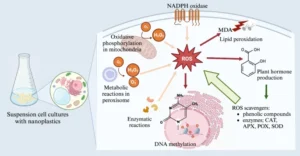
Recent advances in knowledge suggest that micro- and nanoplastics pose a threat to plant health, however, the responses of plants to this stressor are not well-known. Here we examined the response of plant cell defence mechanisms to nanoparticles of commonly used plastic, polystyrene. We used plant cell cultures of widely cultivated plants, the monocots wheat and barley (Triticum aestivum L., Hordeum vulgare L.) and the dicots carrot and tomato (Daucus carota L., Solanum lycopersicum L.). We measured the activities of enzymes involved in the scavenging of reactive oxygen species and nonenzymatic antioxidants and we estimated potential damages in plant cell structures and functioning via lipid peroxidation and DNA methylation levels. Our results demonstrate that the mode of action of polystyrene nanoparticles on plant cells involves oxidative stress. However, the changes in plant defence mechanisms are dependent on plant species, exposure time and nanoplastic concentrations. In general, both monocots showed similar responses to nanoplastics, but the carrot followed more the response of monocots than a second dicot, a tomato. Higher H2O2, lipid peroxidation and lower enzyme activities scavenging H2O2 suggest that tomato cells may be more susceptible to polystyrene-induced stress. In conclusion, polystyrene nanoplastics induce oxidative stress and the response of the plant defense mechanisms involving several chain reactions leading to oxidoreductive homeostasis.

Keywords : Microplastics ; Nanoplastics ; Polystyrene ; Agricultural production ; Plastic
Published in Scientific Report, 13, the 16th December 2023 (Article number : 22423)
https://www.nature.com/articles/s41598-023-50104-5
Please find the full article here.